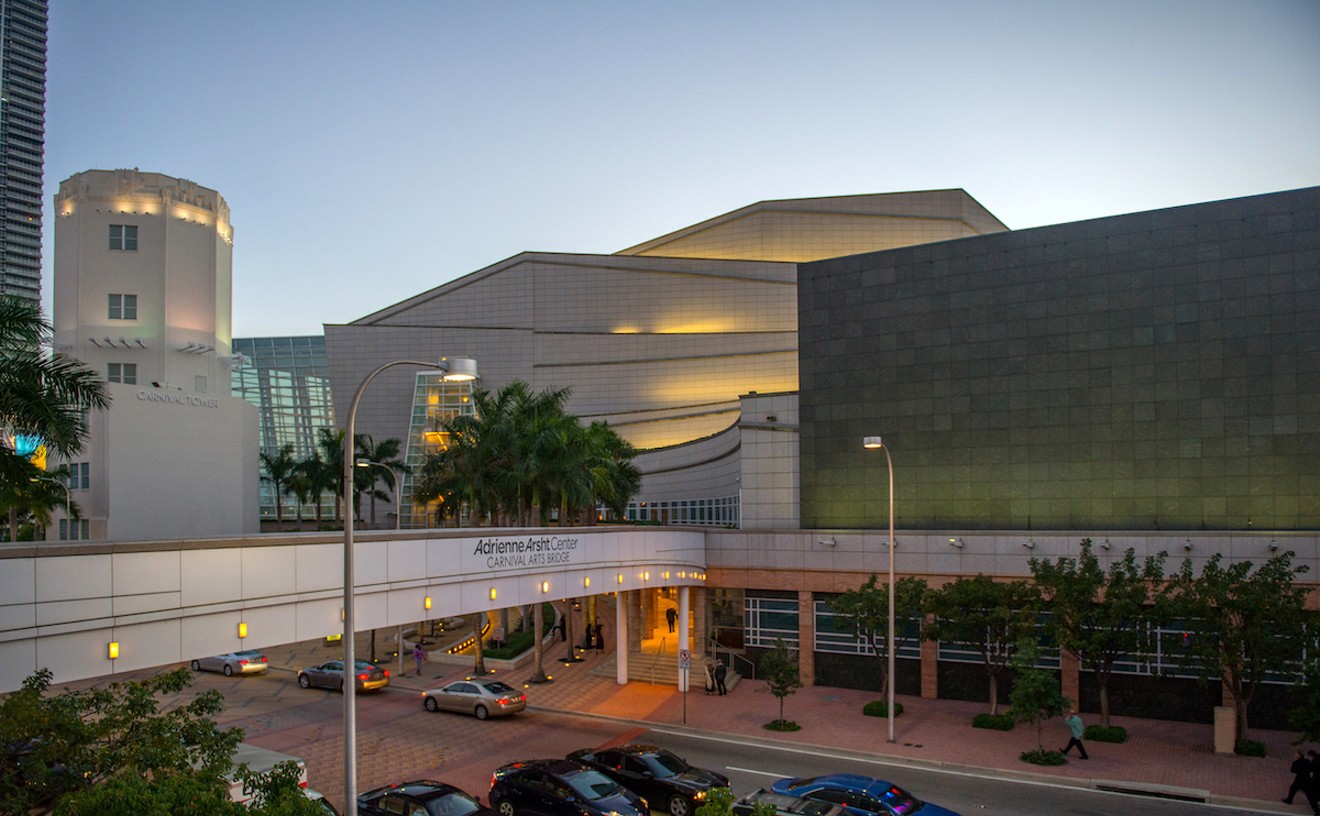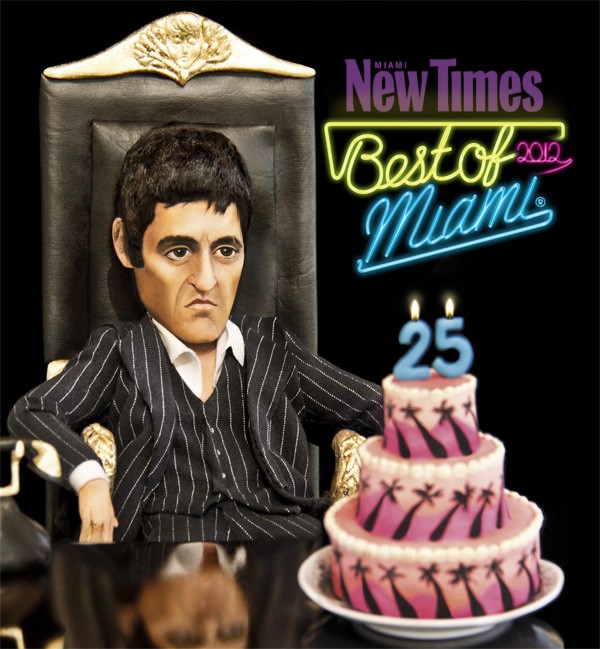With all the handwringing that University of Miami fans were doing last year, they might have missed a historic, lineman-shredding effort by their sophomore running back. While former booster Nevin Shapiro was promising to destroy UM football and a decidedly mediocre 6-6 season unraveled on the field, Lamar Miller accomplished something no Cane had done in nearly a decade: topping 1,000 yards on the ground. (The last guy to do it? You may have heard of Willis McGahee.) In Miller's first season as a starter, the five-foot-11, 212-pound Miami Killian Senior High grad stiff-armed his way to seven different hundred-yard games, bashed in nine touchdowns, and finished with 1,272 yards on the year. Sadly for the orange-and-green, soon after his final game, the 20-year-old wrecking ball tweeted a farewell to the U — "It was a blessing to be a Miami Hurricane," he wrote — and declared for the NFL draft. Let's hope someone at Dolphins HQ took note of the righteous ass-kicking Miller left on the field in his last year in Coral Gables.
Best Tennis Courts
Tropical Park Tennis Center
Unless you live in Southwest Dade, the Tropical Park Tennis Center isn't exactly convenient — but therein lies its unique appeal. You can actually nab a court without lurking for hours or booking days or weeks in advance. Sure, reservations are recommended during the peak hours of 6 to 9 p.m. (courts are open till 10 Monday through Thursday and 8:15 on weekends), but stop by on a weekday afternoon and you and your partner might just find yourselves playing in solitude. The dozen courts are well manicured, with few if any of the disorienting cracks that mar most public tennis courts. And if you find yourself in a queue for a court, there's almost always room to practice your stroke on one of eight nearby racquetball courts. Plus the price isn't bad: $3 per person per hour before 6 p.m. and $4 thereafter.
- 7900 SW 40th St., Miami, 33155 Map
- 786-224-1500
- www.tropicalparktennis.com
Best Movie Shot on Location
Life and Freaky Times of Uncle Luke
Plenty of films were shot in Miami this year. But only one of them featured the life story of 2 Live Crew's Luther "Uncle Luke" Campbell, as told by two of our city's quirkiest and most entertaining artists: filmmakers Jillian Mayer and Lucas Leyva. Are we biased, considering that both Leyva and Mayer have won New Times MasterMind Awards and that Uncle Luke writes a column for our publication? Perhaps. But we're sure as hell not alone in fawning over this film. Life and Freaky Times of Uncle Luke received a rousing welcome at festivals from Sundance to South by Southwest. (It might have been in part due to the filmmakers' creative additions to the festivals' swag bags: whoopee cushions printed with a cartoon version of Uncle Luke.) Life and Freaky Times injected homegrown Miami talent into the international film scene. But it's also simply a damn fine movie, immersing the ever-entertaining Uncle Luke inside a fantasy world of Mayer's creation, featuring cartoonish, colorful handmade sets and adorably lo-fi special effects. There are booties and boobs and science and more booties and a whole lot of screaming. At one point, a character confirms to Luke what we've known all along: "According to our extensive research, you are the realest nigga in Miami." And it all proves that 20 years and a genre change later, Miami's artists are still as nasty as they wanna be.
Best Musical
Million Dollar Quartet

The true-life events of the Million Dollar Quartet jam session of December 4, 1956 — when Elvis Presley and Johnny Cash popped in to Sam Phillips's legendary studio Sun Records to catch a Carl Perkins recording session while up-and-coming piano rocker Jerry Lee Lewis sat in — are found scattered through biographies, a scratchy recording, and word-of-mouth accounts. The account is more apocryphal than actual history, but this dazzling musical transported audiences to that fateful afternoon of the winter of '56. The actors portraying the iconic foursome oozed gobs of talent. With voice and movement, they blew away the crowd. They didn't just mimic the foursome; they slipped into their skins. Even more impressive was that the performers played their own instruments. Lee Ferris shone as the often-frustrated Carl Perkins, and his phenomenal guitar solos were the highlight of each song. Derek Keeling as Johnny Cash was superb, bringing down the house when his booming baritone belted out "Folsom Prison Blues" and "I Walk the Line." Cody Slaughter nailed it as the young, sexually charged Elvis, with his swiveling hips, crooked smile, and country-boy humility. And the production's standout was Martin Kaye as the kinetic and cocky Jerry Lee Lewis. Million Dollar Quartet was at once a time capsule, a concert, and a celebration of the birth of rock through myth, magic, and music.
- 1300 Biscayne Blvd., Miami, 33132 Map
- 305-949-6722
- arshtcenter.org
Best TV Show Set in Miami
Magic City
It's the middle of the day on Ocean Drive a half-century ago. Cuban men sit in folding chairs on the grassy strip now known as Lummus Park, strumming tiny guitars and singing in Spanish. A businessman in a breezy white suit approaches and lingers for a moment to enjoy the music. Behind them, shiny pastel cars glide past pedestrians in circle skirts and cat's-eye sunglasses. Everything, from the familiar façades of the hotels in the background to the sepia tinge that the late-afternoon sun casts in the summertime, is picture-perfect Miami. Scenes such as those are what elevate Magic City from a standard premium-cable corruption drama to a loving homage to Miami's past. Sure, this town had its problems back in the day: political unrest brewing in Cuba, union scuffles and workers' disputes here at home, and just as many shady dealings then as today. But those times are the foundation upon which the city we call home was built, and this Starz drama does them justice. For that reason alone, you gotta love it. Of course, that's not the only reason to watch. Like any good cable show, Magic City treats viewers to healthy doses of T&A, with copious sex scenes steaming up the already-humid air. Plus, the performances that Jeffrey Dean Morgan and company turn in are as convincing as the scenery itself — and yes, the action was filmed in Miami, not some L.A. set designer's version of it. Magic City's elements combine into a sexy, stylish, sleazy, dramatic, and addictive package — much like Miami itself.
Best TV News Anchor
Laurie Jennings
Three haiku about Laurie Jennings:
Soft! Lighter than air,
She glides behind her news desk
In a chair sans wheels.
United Way... eh.
Her community service
Is her smile, homey.
Her calm, sexy voice,
Her face on every screen
When robots take over.
Best TV Host
Roxanne Vargas
As host of NBC 6's 6 in the Mix, Roxanne Vargas doesn't get to cover the same breaking news stories she reports for the station's morning show. But she goes into each cooking segment and "Melt-Proof Make-Up" item with unflagging enthusiasm and genuine interest. As a result, she elicits unexpected responses and humanity from guests who thought they were going on television simply to spend a couple of minutes talking about what swimsuit is best for your butt. Take, for example, her interview with Nicolas Cage, whom she took as seriously as she would have taken the pope. Vargas asked of Cage's oft-ridiculed role as the flaming-skulled Ghost Rider: "What was it like essentially to embrace this dual role?" Cage, unexpectedly, gave a reasoned and interesting answer: "Anyone who has lived for eight years with the curse of his head exploding in flames and turning into a skull would go a little nuts. And this movie allowed me to go there and open that door." That's the most sense Nick Cage has made in a decade.
Best TV Reporter
Gary Nelson
One day, we'd like to see Gary Nelson dressed in a tweed suit and a fedora as he narrates pulp noir novels on the stage of a local theater. He possesses the perfect baritone to match his skills as a storyteller. Even when reporting on the mundane, everyday events of the evening news, Nelson keeps viewers on the edge of their seats. Born and raised in Gainesville, Nelson has never left the Sunshine State during his 42-year broadcasting career, although he has gone on many overseas assignments that landed him several Emmy and Associated Press honors. Among his award-winning pieces was a 2008 exposé on former Miami police chief John Timoney receiving a free Lexus, and his revelations last year that more charter schools failed the FCAT than public schools in Miami-Dade and Broward. The wily journalist is a master at landing scoops. He was the first to interview Frank Acosta, a student at Barbara Goleman High who was arrested for stabbing a classmate who allegedly attacked him. More recently, Nelson was the first reporter to bum-rush Peyton Manning when he came to Miami shortly after the hall-of-fame quarterback was released by the Indianapolis Colts.
Best Spanish-Language TV Personality
Jorge Ramos
Jorge Ramos is hard to miss. Long before Anderson Cooper was strutting around conflict zones in a tight black T-shirt, the original silver fox was stalking presidents for exclusive interviews. During his 27 years at Univision, Ramos has helped grow the Spanish-language station into one of the most powerful in the Americas. Since starting his Sunday morning talk show Al Punto in 2007, he has almost single-handedly shown that Hispanics are a political force to be reckoned with. He has interviewed Barack Obama, Mitt Romney, Newt Gingrich, and even Arizona's vigilante sheriff, Joe Arpaio. Yet despite his international reach, Ramos is far from the first name you think of when it comes to Miami's prensa power brokers. One reason is that Ramos — Mexican-born but now an American citizen — and his station cater to a mostly Mexican audience. Univision's studio may be in Doral, but its audience has traditionally been in Texas, California, or New York, not Florida. But a recent spat between Ramos and Florida Sen. Marco Rubio proves that Univision's relevance — along with its audience — is growing in Miami. After months of trying to track down Rubio for an interview, Univision execs told the senator that Al Punto would run a story about how his brother-in-law had past convictions for drug trafficking. If the senator granted Ramos an interview, however, the stand-alone story might not air, they allegedly said. Rubio's team leaked news of the negotiations to the Miami Herald and the story exploded. But the flap didn't dent Ramos's popularity. If anything, it just showed his expanding influence. El zorro plateado is here to stay.
Best Meteorologist
Max Mayfield
During hurricane season, Miamians need gravitas and real experience to firmly pull their eyes to that terrifying map swirling behind their meteorologist's frantically waving arms. Max Mayfield, more than anyone else in town, knows when to cover up and get out of a hurricane's way. Some meteorologists do their reporting by putting the top down on their drive to work, but Mayfield's street cred is real. After predicting weather for the Air Force, he spent 35 years at the National Hurricane Center, including seven as its director. The guy lives extreme weather; his favorite Bible verse is Matthew 7:24-27, which is about rain and flooding. Is his favorite Billy Joel album Storm Front? If his son misbehaved, would Mayfield call him "El Niño"? We may never know, but you can count on this: When hurricane season rolls around, Mayfield is there with his easy smile and Oklahoma drawl.





